25 abandoned Yugoslavia monuments that look like they’re from the future
“These structures were commissioned by former Yugoslavian president Josip Broz Tito in the 1960s and 70s to commemorate sites where WWII battles took place or where concentration camps stood. They were designed by different sculptors and architects, conveying powerful visual impact to show the confidence and strength of the Socialist Republic. In the 1980s, these monuments attracted millions of visitors per year, especially young pioneers for their ‘patriotic education.’ After the Republic dissolved in early 1990s, they were completely abandoned, and their symbolic meanings were forever lost. From 2006 to 2009, Kempenaers toured around the ex-Yugoslavia region with the help of a 1975 map of memorials, bringing before our eyes a series of melancholy yet striking images.”
Tag: -architecture
Geometric sandcastles by Calvin Seibert
Seibert on his process:
Building “sandcastles” is a bit of a test. Nature will always be against you and time is always running out. Having to think fast and to bring it all together in the end is what I like about it…When they are successful they don’t feel contained or finished. They become organic machines that might grow and expand. I am always adding just one more bit and if time allowed I wouldn’t stop.
Auroville (City of Dawn) is an “experimental” township in Viluppuram district in the state of Tamil Nadu, India, near Puducherry in South India. It was founded in 1968 by Mirra Alfassa (also known as “The Mother”) and designed by architect Roger Anger. As stated in Alfassa’s first public message about the township, “Auroville is meant to be a universal town where men and women of all countries are able to live in peace and progressive harmony, above all creeds, all politics and all nationalities. The purpose of Auroville is to realize human unity.”
Inspired by another post here on Tumblr, I decided to look into the Kowloon Walled City in Hong Kong a bit more, it truly was one of the most amazing and terrifying places on earth. Being slightly smaller than an NFL stadium, the structure was built of 350 smaller interconnected buildings and hosted, at it’s peak, a population density of 5 million people per square mile.
To put those numbers in perspective, this would be like taking the entire population of metro Philadelphia, the 4th largest in the US, and putting it in 1 square mile instead of 1,744.
The area was also largely ungoverned and unregulated. Factories, apartments, schools, temples, churches, shops, cafes, hotels and almost anything else one could imagine were housed within the structure that never had a full blueprint of it done. Buildings were built onto buildings, expanded, rebuilt, and re-purposed as needed without a central authority of any kind.
Within the structure, natural light was almost non-existent, and an unknown number of miles of jury-rigged wires provided electricity to everything. Water constantly dripped down to the lower levels from both rain and leaking pipes, while garbage filled every passage. A constant yellow haze filled the structure and there were never any government safety inspections.
The Kowloon Walled City was demolished in the early 1990s as part of the deal that returned Hong Kong to the Chinese from the British. The entire area is now a park.
I find places like this fascinating, it is just incredible what we, humans, build and live in. This, hive, for lack of a better term, was one of the most interesting structures I’ve yet looked at.
For a documentary shot inside of the Kowloon Walled City, check here:
























